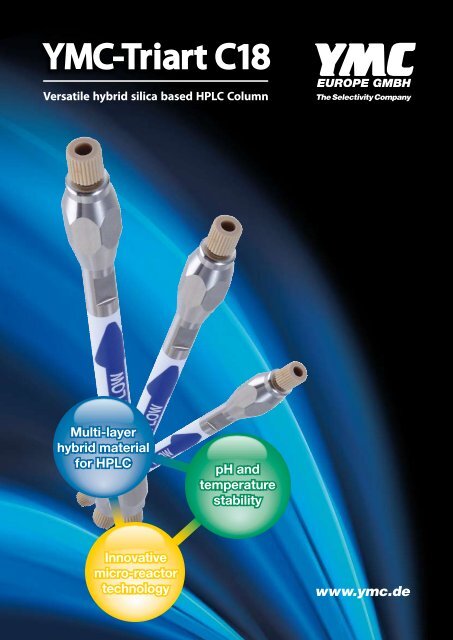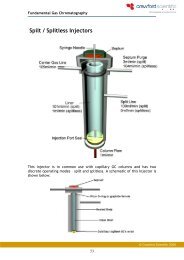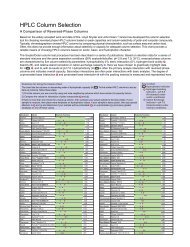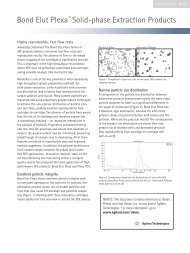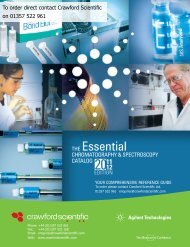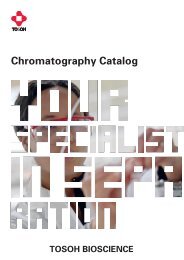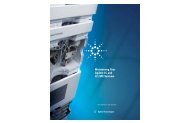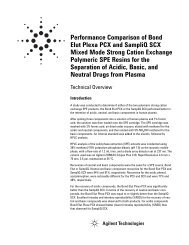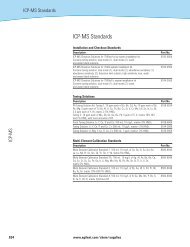YMC Triart C18 Brochure - Crawford Scientific Ltd.
YMC Triart C18 Brochure - Crawford Scientific Ltd.
YMC Triart C18 Brochure - Crawford Scientific Ltd.
Create successful ePaper yourself
Turn your PDF publications into a flip-book with our unique Google optimized e-Paper software.
<strong>YMC</strong>-<strong>Triart</strong> <strong>C18</strong><br />
Versatile hybrid silica based HPLC Column<br />
Multi-layer<br />
hybrid material<br />
for HPLC<br />
Innovative<br />
micro-reactor<br />
technology<br />
pH and<br />
temperature<br />
stability<br />
The Selectivity Company<br />
www.ymc.de
2<br />
<strong>YMC</strong>-<strong>Triart</strong><br />
Particle Technology ................................................................................................... page 4<br />
Physicochemical Characteristics ...................................................................... page 5-6<br />
Surface Modification ............................................................................................. page 6-7<br />
Reproducibility Data ............................................................................................. page 8-9<br />
Application ........................................................................................................... page 10-14<br />
Ordering Information ............................................................................................. page 15<br />
Schöttmannshof 19 · D-46539 Dinslaken · Phone +49 (0) 20 64 427-0 · Telefax +49 (0) 20 64 427-222<br />
E-Mail: info@ymc.de · www.ymc.de
<strong>YMC</strong>-<strong>Triart</strong><br />
Chromatographers are seeking versatile HPLC columns which will perform<br />
day-to-day with ever-changing pH, buffers and temperature conditions. In<br />
order to meet these challenging demands we need HPLC columns that are<br />
able to cope with extreme conditions.<br />
Where can one find a column suitable for harsh pH conditions in combination<br />
with high temperature ranges without sacrificing selectivity?<br />
<strong>YMC</strong>-<strong>Triart</strong>: the versatile multi-layered hybrid silica material!<br />
Multi-layer<br />
hybrid material<br />
for HPLC<br />
Innovative<br />
micro-reactor<br />
technology<br />
pH and<br />
temperature<br />
stability<br />
Schöttmannshof 19 · D-46539 Dinslaken · Phone +49 (0) 20 64 427-0 · Telefax +49 (0) 20 64 427-222<br />
E-Mail: info@ymc.de · www.ymc.de<br />
3
4<br />
Particle technology<br />
<strong>YMC</strong>-<strong>Triart</strong> is a multi-layered material prepared from well-controlled particle<br />
formation technology which is adapted from micro-reactor technology. The<br />
recently developed production step results in truly narrow particle and pore<br />
size distributions!<br />
With <strong>YMC</strong>-<strong>Triart</strong>, challenging pH and high temperature conditions are no<br />
longer a limitation to the day-to-day work in laboratories. Most importantly,<br />
due to its unique particle composition, a balanced hydrophobicity and silanol<br />
activity are achieved which makes <strong>YMC</strong>-<strong>Triart</strong> a ”First Choice“ column in<br />
method development!<br />
<strong>YMC</strong>-<strong>Triart</strong> hybrid structure<br />
inorganic silane layer<br />
organic silane layer<br />
Schöttmannshof 19 · D-46539 Dinslaken · Phone +49 (0) 20 64 427-0 · Telefax +49 (0) 20 64 427-222<br />
E-Mail: info@ymc.de · www.ymc.de
Uniform spherical particles<br />
<strong>YMC</strong>-<strong>Triart</strong> <strong>C18</strong> X-Bridge HILIC<br />
The new uniform spherical particle support is adopted for <strong>YMC</strong>-<strong>Triart</strong> <strong>C18</strong>.<br />
The particle is produced using micro-reactor technology in granulation<br />
process. This results in reduction of the back-pressure and leads to more<br />
reproducibility in surface modification.<br />
Low column back-pressure<br />
Column: 5 µm, 150 x 4.6 mm ID<br />
Eluent: acetonitrile/water or methanol/water<br />
Flow rate: 1.0 ml/min<br />
Temperature: 25 °C<br />
The revolutionary production technique,<br />
adapted from micro-reactor flow technology,<br />
produces a multi-layered silcia/<br />
organic hybrid stationary phase, with<br />
outstanding narrow pore size and particle<br />
size distributions which result in<br />
low back pressures.<br />
<strong>YMC</strong>-<strong>Triart</strong> <strong>C18</strong> is designed for use under many<br />
conditions. Elution with higher viscosity methanol<br />
(compared with acetonitrile), <strong>YMC</strong>-<strong>Triart</strong> <strong>C18</strong> generates<br />
lower pressure (approx 30% lower than with<br />
conventional phases).<br />
Application courtesy of <strong>YMC</strong> Co., <strong>Ltd</strong>.<br />
Schöttmannshof 19 · D-46539 Dinslaken · Phone +49 (0) 20 64 427-0 · Telefax +49 (0) 20 64 427-222<br />
E-Mail: info@ymc.de · www.ymc.de<br />
5
6<br />
d Vp/<br />
d logD<br />
Narrow pore distribution<br />
4500<br />
4000<br />
3500<br />
3000<br />
2500<br />
2000<br />
1500<br />
1000<br />
1.<br />
5<br />
500<br />
0<br />
0<br />
5<br />
10<br />
<strong>Triart</strong> <strong>C18</strong> particle<br />
Conventional silica-based particle<br />
15 20<br />
Pore size (nm)<br />
This figure shows the pore size distributions of some competitive materials. Compared<br />
with other products on the market, <strong>YMC</strong>-<strong>Triart</strong> <strong>C18</strong> shows a narrower distributon which<br />
results in sharper peak shapes.<br />
Improved loadability<br />
Influence of injection volume on peak shapes<br />
1 2<br />
Application courtesy of <strong>YMC</strong> Co., <strong>Ltd</strong>.<br />
1<br />
2.<br />
0<br />
1<br />
2<br />
Peak anomaly at 1.5 µL<br />
<strong>YMC</strong>-<strong>Triart</strong> <strong>C18</strong><br />
Hybrid-silica based <strong>C18</strong><br />
2<br />
Silica-based <strong>C18</strong><br />
2.<br />
5<br />
acetonitrile<br />
1.0 µL<br />
1.5 µL<br />
2.0 µL<br />
3.0 µL<br />
Schöttmannshof 19 · D-46539 Dinslaken · Phone +49 (0) 20 64 427-0 · Telefax +49 (0) 20 64 427-222<br />
E-Mail: info@ymc.de · www.ymc.de<br />
1.<br />
25<br />
solvent for sample<br />
injection volume<br />
OCH2CHCH2NHCH(CH3)2<br />
OH<br />
Propranolol 50 µg/mL<br />
2.<br />
H3CO<br />
H3CO<br />
30<br />
Column: 5 µm, 50 x 2.0 or 2.1 mm ID<br />
Eluent: A) water / formic acid (100/0.1)<br />
B) acetonitrile / formic acid<br />
(100/0.1)<br />
5% B (0-0.5 min), 5-100% B<br />
(0.5-2.5 min)<br />
Flow rate: 0.4 ml/min<br />
Temperature: 40 °C<br />
Detection: UV at 275 nm<br />
CN CH3<br />
C (CH2)3NCH2CH2<br />
CH(CH3)2<br />
Verapamil 50 µg/mL<br />
In order to prevent peak errors, there is the limit to the injection volume when the sample is<br />
injected in high elution solvents (such as acetonitrile). Compared with traditional columns,<br />
more than double the injection volume can injected into <strong>YMC</strong>-<strong>Triart</strong> <strong>C18</strong> as a result of the<br />
extremely narrow particle size distribution.<br />
min<br />
X-Bridge HILIC<br />
OCH3<br />
35<br />
OCH3
Multi-stage endcapping<br />
After bonding the alkyl chain, there are highly reactive and less reactive silanols<br />
on the surface. In traditional bonding processes, these reacted with<br />
a single capping-compound in one step. However, the highly reactive silanols<br />
can be hydrolysed easily which contributes to the poor durability.<br />
The less reactive silanols are hard to endcap which results in poor resolution<br />
due to peak tailing.<br />
Before<br />
EC 1<br />
STEP<br />
2<br />
STEP<br />
Hydroxyl group<br />
End-capping (EC) group<br />
3<br />
STEP<br />
<strong>YMC</strong>-<strong>Triart</strong> <strong>C18</strong> uses a new innovation in end capping called “multistage end-capping”<br />
for its surface modification process. By using a number of compounds with the different<br />
reactivities in successive steps, all silanols can be capped to the maximum extent.<br />
Ingredients in cough/cold medication:<br />
1. Chlorpheniramine; 2. Detromethorphan;<br />
3. Propyl p-hydroxybenzoate<br />
Column: 5 µm, 150 x 3.0 mm ID<br />
Eluent: 20 mM KH 2PO 4-K 2HPO 4<br />
(pH 6.9) / acetonitrile (65/35)<br />
Flow rate: 0.425 ml/min<br />
Temperature: 40 °C<br />
Detection: UV at 235 nm<br />
Application courtesy of <strong>YMC</strong> Co., <strong>Ltd</strong>.<br />
Schöttmannshof 19 · D-46539 Dinslaken · Phone +49 (0) 20 64 427-0 · Telefax +49 (0) 20 64 427-222<br />
E-Mail: info@ymc.de · www.ymc.de<br />
7
8<br />
Batch-to-Batch reproducibility<br />
Excellent reproducibility of <strong>YMC</strong>-<strong>Triart</strong> <strong>C18</strong> is shown even for the analysis for basic and<br />
coordination compounds which normally exhibit tailing and adsorption effects.<br />
Basic compounds Coordination compounds<br />
1<br />
2<br />
3<br />
Lot. E<br />
Lot. D<br />
Lot. C<br />
Lot. B<br />
Lot. A<br />
Lot. A<br />
0.0 2.5 5.0 7.5 10.0 12.5 15.0 17.5 min<br />
0.0 2.0 4.0 6.0 8.0 10.0 12.0 14.0 min<br />
J091201Y J091201X<br />
Theoretical plate number<br />
Column: 5 µm, 150 x 3.0 mm ID<br />
Eluent: 20mM KH 2PO 4 (pH 6.9) / acetonitrile (65/35)<br />
Flow rate: 0.425 ml/min<br />
Temperature: 40 °C<br />
Detection: UV at 235 nm<br />
The reproducibility of packed columns is shown below in terms of theoretical plate<br />
number (N) and tailing factor (Tf). <strong>YMC</strong> <strong>Triart</strong> <strong>C18</strong> packed columns exhibit a very narrow<br />
range of variation.<br />
20000<br />
15000<br />
10000<br />
5000<br />
0<br />
Column: 5 µm, 150 x 4.6 mm ID<br />
Eluent: acetonitrile / water (40/60)<br />
Flow rate: 1.0 ml/min<br />
Temperature: ambient<br />
Sample: butyl benzoate<br />
Application courtesy of <strong>YMC</strong> Co., <strong>Ltd</strong>.<br />
Theoretical plate number<br />
Column: 5 µm, 150 x 3.0 mm ID<br />
Eluent: acetonitrile / 0.1% H 3PO 4 (40/60)<br />
Flow rate: 0.425 ml/min<br />
Temperature: 40 °C<br />
Detection: UV at 254 nm<br />
Tailing factor<br />
10 20 30 40 50<br />
Column number<br />
Schöttmannshof 19 · D-46539 Dinslaken · Phone +49 (0) 20 64 427-0 · Telefax +49 (0) 20 64 427-222<br />
E-Mail: info@ymc.de · www.ymc.de<br />
1<br />
2<br />
2.5<br />
2.0<br />
1.5<br />
1.0<br />
0.5<br />
Lot. E<br />
Lot. D<br />
Lot. C<br />
Lot. B<br />
Tailing factor
Phosphate buffer (pH 11.5, 40 °C)<br />
120%<br />
100%<br />
80%<br />
60%<br />
40%<br />
20%<br />
Silica based <strong>C18</strong><br />
<strong>YMC</strong>-<strong>Triart</strong> <strong>C18</strong><br />
Hybrid-silica based <strong>C18</strong><br />
Rate of theoretical plate number Versatile wide pH stability<br />
0%<br />
0 10 20 30<br />
Time (hr)<br />
40 50<br />
Column: 5 µm, 150 x 4.6 mm ID<br />
Eluent: 50 mM K 2HPO 4-K 3PO 4 (pH 11.5) /<br />
methanol (90/10)<br />
Flow rate: 1.0 ml/min<br />
Temperature: 40 °C<br />
Sample: benzyl alcohol<br />
Durability at high temperature<br />
pH 6.9, 70 °C<br />
Rate of theoretical plate number<br />
120%<br />
100%<br />
80%<br />
60%<br />
40%<br />
20%<br />
Silica based <strong>C18</strong><br />
<strong>YMC</strong>-<strong>Triart</strong> <strong>C18</strong><br />
Silica based <strong>C18</strong><br />
alkaline-resistant type<br />
0%<br />
0 100200 300400 500600 700<br />
Time (hr)<br />
Column: 5 µm, 50 x 2.0 mm ID<br />
Eluent: 20 mM KH 2PO 4-K 2HPO 4 (pH 6.9) /<br />
acetonitrile (90/10)<br />
Flow rate: 0.2 ml/min<br />
Temperature: 70 °C<br />
Sample: phenol<br />
Triethylamine (pH 11.5, 40 °C)<br />
0%<br />
0 50 100 150<br />
Time (hr)<br />
200 250 300<br />
Application courtesy of <strong>YMC</strong> Co., <strong>Ltd</strong>.<br />
Schöttmannshof 19 · D-46539 Dinslaken · Phone +49 (0) 20 64 427-0 · Telefax +49 (0) 20 64 427-222<br />
E-Mail: info@ymc.de · www.ymc.de<br />
Rate of theoretical plate number<br />
120%<br />
100%<br />
80%<br />
60%<br />
40%<br />
20%<br />
Silica based <strong>C18</strong><br />
<strong>YMC</strong>-<strong>Triart</strong> <strong>C18</strong><br />
Column: 5 µm, 150 x 4.6 mm ID<br />
Eluent: 50 mM triethylamine (pH 11.5) /<br />
methanol (90/10)<br />
Flow rate: 1.0 ml/min<br />
Temperature: 40 °C<br />
Sample: benzyl alcohol<br />
pH 1, 70 °C<br />
0%<br />
0 20 40 60<br />
Time (hr)<br />
80 100 120<br />
Test conditions<br />
Column: 5 µm, 50 x 2.0 mm ID<br />
Eluent: acetonitrile / water (60/40)<br />
Flow rate: 0.2 ml/min<br />
Temperature: 70 °C<br />
Sample: butyl benzoate<br />
<strong>YMC</strong>-<strong>Triart</strong> <strong>C18</strong> shows great chemical stability provided by newly developed hybrid-silica.<br />
Even in high-pH or high-temperature conditions, the lifetime of <strong>YMC</strong>-<strong>Triart</strong> <strong>C18</strong> is more<br />
than 10x greater than conventional ODS columns.<br />
Rate of theoretical plate number<br />
120%<br />
100%<br />
80%<br />
60%<br />
40%<br />
20%<br />
<strong>YMC</strong>-<strong>Triart</strong> <strong>C18</strong><br />
Silica based <strong>C18</strong><br />
Hybrid-silica based <strong>C18</strong><br />
The columns are stored in acetonitrile/water/TFA (10/90/1) 70 °C,<br />
and the performance tested every 20 hours.<br />
9
10<br />
Hydrogen boning capacity<br />
a (caffeine/benzene)<br />
First choice column for method development<br />
Hydrophobicity k‘ (amylbenene)<br />
Standard ODS<br />
The most versatiled<br />
columns as first-choice.<br />
Conventional hybrid silica-based ODS columns tend to be less hydrophobic than silica-based<br />
columns. <strong>YMC</strong>-<strong>Triart</strong> <strong>C18</strong> has a higher carbon load, making its hydrophobicity<br />
comparable to standard ODS columns, making it a ”versatile first-choice“ column<br />
for method development.<br />
Specification<br />
Base organic/inorganic silica<br />
Stationary phase <strong>C18</strong> (as USP L1)<br />
Particle size 3 and 5 µm<br />
Pore size 12 nm<br />
Carbon load 20%<br />
Bonding polymeric type<br />
End-capping multi-stage hybrid groups<br />
pH range 1 ~ 12<br />
Temperature range pH 1-7: 70 °C, pH 7-12: 50 °C<br />
Application courtesy of <strong>YMC</strong> Co., <strong>Ltd</strong>.<br />
Schöttmannshof 19 · D-46539 Dinslaken · Phone +49 (0) 20 64 427-0 · Telefax +49 (0) 20 64 427-222<br />
E-Mail: info@ymc.de · www.ymc.de
Basic compounds<br />
Column: 5 µm, 150 x 3.0 or 150 x 4.6 mm ID<br />
Eluent: 20 mM KH 2PO 4-K 2HPO 4 (pH 6.9) /<br />
acetonitrile (65/35)<br />
Flow rate: 0.425 ml/min for 3.0 mm ID<br />
1.0 ml/min for 4.6 mm ID<br />
Temperature: 40 °C<br />
Detection: UV at 235 nm<br />
The innovative surface modification technology results in excellent peak shapes even for<br />
basic compounds that often exhibit peak tailing with conventional silica- and hybrid silica-<br />
based ODS columns.<br />
Fast LC for conventional HPLC<br />
insufficient<br />
separation<br />
Eluent: A) water/HFBA* (100/0.1)<br />
B) acetonitrile/HFBA* (100/0.1)<br />
Temperature: 37 °C<br />
Detection: UV at 290 nm<br />
Injection: 1 µl (0.1 mg/ml)<br />
*heptafluorobutyric acid<br />
optimisation<br />
Baseline separation,<br />
but long analysis time<br />
Down scaling<br />
Application courtesy of <strong>YMC</strong> Co., <strong>Ltd</strong>.<br />
Schöttmannshof 19 · D-46539 Dinslaken · Phone +49 (0) 20 64 427-0 · Telefax +49 (0) 20 64 427-222<br />
E-Mail: info@ymc.de · www.ymc.de<br />
11
12<br />
Coordinating compounds<br />
Column: 5 µm, 150 x 3.0 or 150 x 4.6 mm ID<br />
Eluent: acetonitrile / 0.1% H 3PO 4 (40/60)<br />
Flow rate: 0.425 ml/min for 3.0 mm ID<br />
1.0 ml/min for 4.6 mm ID<br />
Temperature: 40 °C<br />
Detection: UV at 254 nm<br />
<strong>YMC</strong>-<strong>Triart</strong> <strong>C18</strong> has an extremely low level of metal impurities, much lower than conventional<br />
products, enabling to provide excellent peak shape for coordination compounds.<br />
Acidic compounds<br />
Column: 5 µm, 150 x 3.0 or 150 x 4.6 mm ID<br />
Eluent: methanol / 0.1% H 3PO 4 (5/95)<br />
Flow rate: 0.425 ml/min for 3.0 mm ID<br />
1.0 ml/min for 4.6 mm ID<br />
Temperature: 37 °C<br />
Detection: UV at 210 nm<br />
<strong>YMC</strong>-<strong>Triart</strong> <strong>C18</strong> is synthesised using methodology adapted from micro-reactor technology.<br />
This technique ensures a reduction of impurities that contribute to peak tailing<br />
during the analysis of some types acidic compounds.<br />
Application courtesy of <strong>YMC</strong> Co., <strong>Ltd</strong>.<br />
Schöttmannshof 19 · D-46539 Dinslaken · Phone +49 (0) 20 64 427-0 · Telefax +49 (0) 20 64 427-222<br />
E-Mail: info@ymc.de · www.ymc.de
Comparison of clemastine analysis with conventional columns<br />
<strong>YMC</strong>-<strong>Triart</strong> <strong>C18</strong> <strong>C18</strong><br />
50 X x 2.0 mmI.D. mm ID<br />
Silica based <strong>C18</strong> <strong>C18</strong><br />
Inertsil Brand ODS-3V C1<br />
50 X x 2.1 mmI.D. mm ID<br />
Silica<br />
Silica<br />
based<br />
based<br />
<strong>C18</strong><br />
<strong>C18</strong><br />
Capcell Brand D5 Pak MG-II<br />
50 X x 2.0 mmI.D. mm ID<br />
Silica based <strong>C18</strong><br />
Silica based <strong>C18</strong><br />
Sunfire <strong>C18</strong><br />
Brand I6<br />
50 50 x X 2.1 2.1 mmI.D. mm ID<br />
Hybrid-silica based <strong>C18</strong><br />
X-Bridge<br />
50 x 2.1 mm ID<br />
10 mM phosphate buffer (pH 6.7)/organic solvent 10 mM CH3COONH4/organic solvent<br />
methanol acetonitrile<br />
Tf 0.97<br />
F090818H07<br />
Tf 1.21<br />
F090727H07<br />
Tf 0.93<br />
F090717H07<br />
Tf 1.03<br />
Tf 1.14<br />
F090731H07<br />
Tf 1.11<br />
Tf 1.56<br />
Tf 2.83<br />
Tf 3.87<br />
Tf 1.88<br />
F090731I07<br />
methanol acetonitrile<br />
Tf 1.03<br />
Tf 1.13<br />
Tf 1.05<br />
Tf 1.13<br />
Tf 1.22<br />
F090731F07<br />
10. 0 11.<br />
0 12.<br />
0 min 6.<br />
0 7.<br />
0 8.<br />
0 min 8.<br />
0<br />
9.0 10.0 min 6.0 7.0<br />
Application courtesy of <strong>YMC</strong> Co., <strong>Ltd</strong>.<br />
Schöttmannshof 19 · D-46539 Dinslaken · Phone +49 (0) 20 64 427-0 · Telefax +49 (0) 20 64 427-222<br />
E-Mail: info@ymc.de · www.ymc.de<br />
F090818I07<br />
F090727I07<br />
F090717I07<br />
F090818F07<br />
F090727F07<br />
F090714F07<br />
8.<br />
0<br />
Tf 1.16<br />
F090817G07<br />
Tf 1.43<br />
F090803G07<br />
Tf 2.21<br />
F090714G07<br />
Tf 1.88<br />
F090722H07 F090722I07<br />
F090722F07<br />
F090722G07<br />
Tf 1.78<br />
F090731G07<br />
Column: 5 µm, 50 x 2.0 or 50 x 2.1 mm ID<br />
Eluent: A) 10 mM KH 2PO 4-K 2HPO 4 (pH 6.7) or 10 mM CH 3COONH 4<br />
B) methanol or acetonitrile<br />
5-90% B (0-10 min), 90% B (10-15 min)<br />
Flow rate: 0.2 ml/min<br />
Temperature: 25 °C<br />
Detection: UV at 230 nm<br />
Clemastine is a well-known basic compound which readily exhibits peak tailing with conventional<br />
ODS columns. <strong>YMC</strong>-<strong>Triart</strong> provides sharp separations with many different buffer/<br />
solvent compositions.<br />
min<br />
13
14<br />
LC/MS compatibility<br />
Application courtesy of <strong>YMC</strong> Co., <strong>Ltd</strong>.<br />
Column: 5 µm, 50 x 2.0 mm ID<br />
Eluent: A) water / formic acid (100/0.1)<br />
B) acetonitrile / formic acid<br />
(100/0.1)<br />
5% B (0-1 min), 5-100% B<br />
(1-5 min), 100% B (5-10 min),<br />
100-5% B (10-10.1 min),<br />
5% B (10.1-12.5 min)<br />
Flow rate: 0.4 ml/min<br />
Temperature: 40 °C<br />
Detection: ESI positive, TIC (Mass Range:<br />
50-1000)<br />
Column bleeding, caused by the fragments of stationary phase, is the main reason for background<br />
noise and limitations on detection limits. No bleed is observed in the test of total ion<br />
current (TIC) measured by LC/MS with blank or with <strong>YMC</strong>-<strong>Triart</strong> <strong>C18</strong>. So in terms of the signalnoise<br />
ratio (S/N ratio), <strong>YMC</strong>-<strong>Triart</strong> <strong>C18</strong> can be expect to not only reduce the background noise<br />
but to also increase the sensitivity of the analysis.<br />
Sure-Fit Connectors<br />
Optimise your chromatographic results!<br />
• Easy column installation<br />
without tools<br />
• Perfect capillary connection<br />
every time<br />
• Optimised resolution and<br />
reproducibility<br />
• Self-adjusting to any port<br />
depth regardless of<br />
column manufacturer<br />
• Fingertight to 6000 psi (425 bar)<br />
• No galling or seizing<br />
• Available with a range of capillary<br />
tubing diameters and lengths for<br />
optimal resolution<br />
Schöttmannshof 19 · D-46539 Dinslaken · Phone +49 (0) 20 64 427-0 · Telefax +49 (0) 20 64 427-222<br />
E-Mail: info@ymc.de · www.ymc.de
Ordering Information<br />
Particle<br />
size<br />
(µm)<br />
Pore<br />
size<br />
(nm)<br />
3 12<br />
Trademarks<br />
Dimension<br />
(mm)<br />
Part<br />
number<br />
50 x 2.0 TA12S030502<br />
75 x 2.0 TA12S03L502<br />
100 x 2.0 TA12S031002<br />
150 x 2.0 TA12S031502<br />
50 x 3.0 TA12S030503<br />
75 x 3.0 TA12S03L503<br />
100 x 3.0 TA12S031003<br />
150 x 3.0 TA12S031503<br />
50 x 4.6 TA12S030546<br />
75 x 4.6 TA12S03L546<br />
100 x 4.6 TA12S031046<br />
150 x 4.6 TA12S031546<br />
250 x 4.6 TA12S032546<br />
SureFit is trademark of Isolation Technologies<br />
Capcell Pak MG-II is trademark of Shiseido Co., <strong>Ltd</strong>.<br />
Inertsil ODS-3V is trademark of GL Sciences<br />
Sunfire <strong>C18</strong>, X-Bridge are trademarks of Waters Corp.<br />
Gemini NX is trademark of Phenomenex, Inc.<br />
Particle<br />
size<br />
(µm)<br />
Pore<br />
size<br />
(nm)<br />
5 12<br />
Dimension<br />
(mm)<br />
Part<br />
number<br />
50 x 2.0 TA12S050502<br />
75 x 2.0 TA12S05L502<br />
100 x 2.0 TA12S051002<br />
150 x 2.0 TA12S051502<br />
50 x 3.0 TA12S050503<br />
75 x 3.0 TA12S05L503<br />
100 x 3.0 TA12S051003<br />
150 x 3.0 TA12S051503<br />
50 x 4.6 TA12S050546<br />
75 x 4.6 TA12S05L546<br />
100 x 4.6 TA12S051046<br />
150 x 4.6 TA12S051546<br />
250 x 4.6 TA12S052546<br />
Schöttmannshof 19 · D-46539 Dinslaken · Phone +49 (0) 20 64 427-0 · Telefax +49 (0) 20 64 427-222<br />
E-Mail: info@ymc.de · www.ymc.de<br />
15
Co., <strong>Ltd</strong>.<br />
<strong>YMC</strong> Karasuma-Gojo Bld. 284 Daigo-cho,<br />
Karasuma Nisiiru Gojo-dori Shimogyo-ku,<br />
Kyoto 600-8106 Japan<br />
TEL. +81(0)75-342-4515, FAX +81(0)75-342-4550<br />
www.ymc.co.jp<br />
Your local distributor:<br />
Holm Street, Strathaven, Lanarkshire,<br />
ML10 6NB, Scotland, UK<br />
Phone: +44 (0)1357 522961, Fax: +44 (0)1357 522168<br />
Email: enquiries@crawfordscientific.com<br />
www.crawfordscientific.com<br />
Europe GmbH<br />
Schöttmannshof 19<br />
D-46539 Dinslaken<br />
Germany<br />
TEL. +49(0)2064/427-0, FAX +49(0)2064/427-222<br />
www.ymc.de<br />
America, Inc.<br />
941 Marcon Boulevard Suite 301<br />
Allentown, PA18109 USA<br />
TEL. +1-610-266-8650, FAX +1-610-266-8652<br />
www.ymcamerica.com<br />
India <strong>Ltd</strong>.<br />
CX - 07, 3rd Floor, Lobe - 1,<br />
Tower - A, The Corenthum, Plot No- A-41,<br />
Sector - 62, Noida - 201301 (UP) India.<br />
TEL. +91(0)120-4276020 - 25, FAX +91(0)120-4276026<br />
www.ymcindia.com


